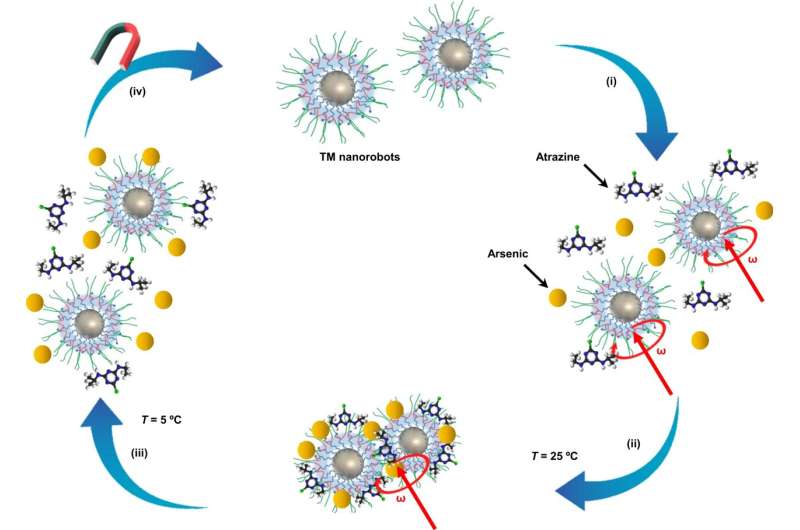March 2, 2022 report
Using nanorobots to help clean heavy metals from polluted water

An international team of researchers has developed nanorobots capable of removing heavy metals from polluted water. In their paper published in the journal Nature Communications, the group describes their nanorobots and how well they worked when tested.
Prior research has shown that heavy metals make their way into the water table through landfill leakage, mining operations and industrial dumping. Heavy metals must be removed from water sources, and current methods call for complicated multi-step procedures to remove them. In this new effort, the researchers report a possible alternative—nanorobots.
The researchers developed thermosensitive magnetic nanorobots capable of bonding with heavy metals under certain circumstances and releasing them under others. The nanorobots (each just 200 nanometers wide) were made using a pluronic tri-block copolymer (PTBC) as an attractant and iron oxide to allow for control via magnetic fields. The copolymer is a temperature-sensitive PTBC. When placed in cool water, the material bonds with heavy metals. When placed in warm water, the bonds relaxed, allowing the metals to separate from the material. In practice, this meant that a group of the nanorobots could be placed into a sample of cool water where they would disperse naturally and bond with any heavy metals they encountered. Then, the nanorobots could be corralled using a magnetic field to a separate site where the water could be heated, releasing the metals. Notably, this arrangement allows the nanorobots to be reused.
The researchers tested their tiny robots by adding heavy metals such as arsenic to a tank of water. They then dumped in a bunch of their nanorobots and then let the sample sit 100 minutes as the nanorobots collected the metals. Next, they collected the nanorobots and measured how much of the heavy elements had been removed from the water. The result was approximately 65%. The researchers note that their work is still in a preliminary phase, but they plan to continue testing their nanorobots to find out if they might be used in actual real-world settings.
More information: Jayraj V. Vaghasiya et al, Pick up and dispose of pollutants from water via temperature-responsive micellar copolymers on magnetite nanorobots, Nature Communications (2022). DOI: 10.1038/s41467-022-28406-5
Journal information: Nature Communications
© 2022 Science X Network





















